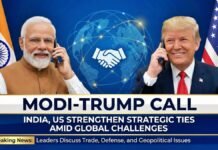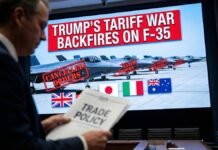
Key Points:
- U.S. markets suffer their worst crash since 2020 after Trump announces sweeping tariffs on 60 countries.
- S&P 500 drops 4%, Nasdaq falls nearly 5%, and Dow Jones loses over 3%.
- Major tech stocks like Apple, Amazon, and Tesla see sharp declines.
- Global markets, crude oil prices, and bond yields also hit hard.
- Economists warn of a potential U.S. and global recession.
Washington D.C.: President Donald Trump’s announcement of sweeping tariffs on imports from over 60 countries has sent shockwaves through financial markets, wiping out $2 trillion in value from U.S. stocks and raising fears of a looming recession. The tariffs, unveiled during his “Liberation Day” speech on April 2, aim to counter what Trump described as decades of unfair trade practices against the United States.
U.S. Stock Market Plunges
The U.S. stock market experienced its worst single-day losses since 2020. The S&P 500 fell by 4%, while the tech-heavy Nasdaq dropped nearly 5%. The Dow Jones Industrial Average lost over 1,600 points, marking a decline of more than 3%. Smaller companies were hit even harder, with the Small Cap 2000 index plummeting by 5.65%.
Tech giants bore the brunt of the sell-off:
- Apple: Down 8.79%, trading at $204.19.
- Amazon: Fell by 7.45%, trading at $181.45.
- Tesla: Also saw steep losses alongside other tech firms like Microsoft, Nvidia, Meta, and Google.
Global Impact
The repercussions extended beyond U.S. borders as global markets reeled from the tariff shock:
- European indices like Germany’s DAX and the Stoxx Europe 600 fell by over 2%.
- Asian markets saw significant declines, with Japan’s Nikkei losing nearly 3% and Hong Kong’s Hang Seng dropping over 1.5%.
Crude oil prices also tumbled sharply—WTI fell by 6.44% to $67.7 per barrel, while Brent crude dropped by 6.23% to $70.26 per barrel. Meanwhile, bond yields on the U.S. Treasury benchmark fell below 4% for the first time in months as investors sought safer assets.
Tariff Details and Economic Concerns
Trump’s tariffs include a universal baseline rate of 10% on all imports to the U.S., with higher rates targeting key trade partners:
- China faces a staggering 54% tariff.
- India is subject to a “reciprocal” tariff of 26%.
- Other countries like Japan (24%), South Korea (25%), and the EU (20%) are also heavily impacted.
Economists warn that these tariffs could exacerbate inflation while reducing consumer demand and corporate profits. JPMorgan estimates the tariffs could add up to $660 billion annually in taxes on American consumers and businesses, marking the largest tax hike since the late 1960s.
Recession Fears Escalate
The economic fallout has raised alarms about a potential recession in both the U.S. and global economies:
- Consumer spending, which drives about 70% of U.S. economic activity, is expected to decline due to higher prices.
- Retaliatory tariffs from affected countries could further disrupt global trade and supply chains.
Olu Sonola of Fitch Ratings noted that the U.S. tariff rate has surged to levels not seen since the early 20th century, warning that “numerous countries are likely to fall into recession.”
Political and Market Reactions
While Trump defended the tariffs as a necessary step to revive American manufacturing, global leaders criticized them as protectionist measures that threaten international trade stability. European Commission President Ursula von der Leyen called them “a major blow” to global economic cooperation.
As markets brace for further volatility, investors are flocking to safe-haven assets like gold, which has surged to record highs above $3,100 per ounce.
The full impact of Trump’s tariffs remains uncertain, but analysts agree that this marks one of the most significant shifts in global trade policy in decades—potentially reshaping economies worldwide for years to come.





















































